For 53 years Jeep has gathered the faithful in the Utah mountains for Jeep Easter Safari, an annual celebration of all things off-roading, rock-crawling and American-made, WWII-bred 4x4s. For a week each spring, the town of Moab is overrun with dented Wranglers rolling high on humongous studded rubber and motel parking lots are filled with the clanging sound of wrenching and the disembodied legs of impromptu mechanics scrambling under a stuck winch or busted sway bar.
And as per tradition, Jeep made unto the Easter Safari a grand offering of functional, meticulously designed concept vehicles for 2019—wild, colorful, official corporate imaginings that hint at the possible future thinking of the design and accessories teams, even the go-fast Mopar performance division, and are made available for shakedown runs along lightly challenging mountain trails.
As expected, the 2019 concepts were built almost exclusively on the new Gladiator chassis, the adoringly reviewed return of Jeep’s pickup truck nameplate. Themes ranged from the tongue-in-cheek — the Flatbill, named for the straight hat brims favored by motocross racers — to the ludicrous aggression of Five-Quarter’s 707-horsepower Hellcrate engine and steampunk-peyote design.
Jeep promises to make none of these vehicles, but here’s a look at what they’ve teased—and which one gets our vote for a proper production run.
In ascending order of preference:
Gladiator Gravity
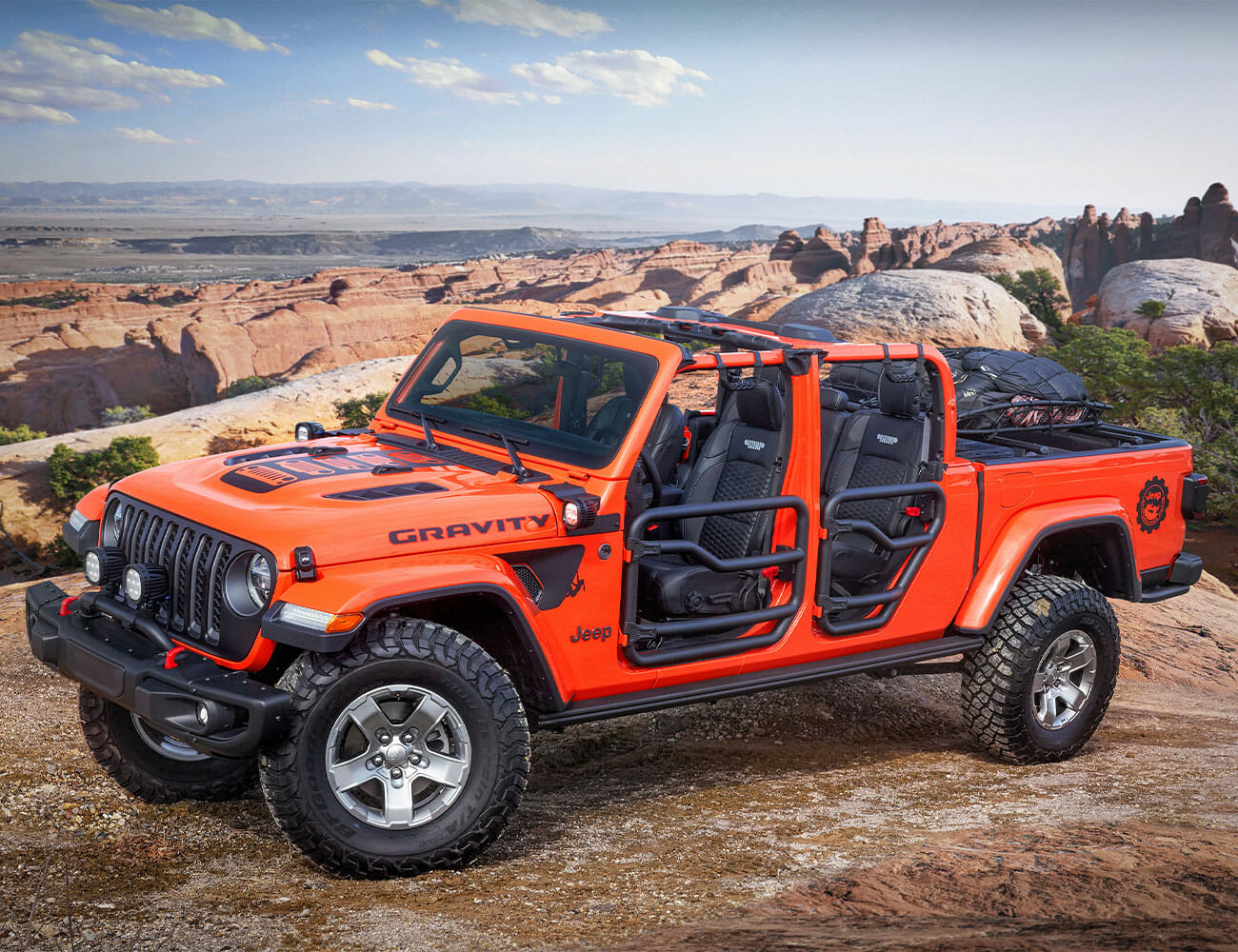
You have to be deep in the life for the Jeep Gladiator Gravity’s stripped down build for rock-climbers — roofless, tube doors, with a two-inch lift kit, heavy steel rock rails, 35-inch tires and a cargo basket. Arguably the most interesting part about the Gladiator Gravity, which started life as a Gladiator Rubicon, is that most everything on the heavily modified truck is purchasable from the Mopar parts catalog. The truck even comes with a cat-back exhaust. But the slidable and lockable drawers in the bed of the truck, enough to hold large amounts of climbing gear, are custom.
Five-Quarter
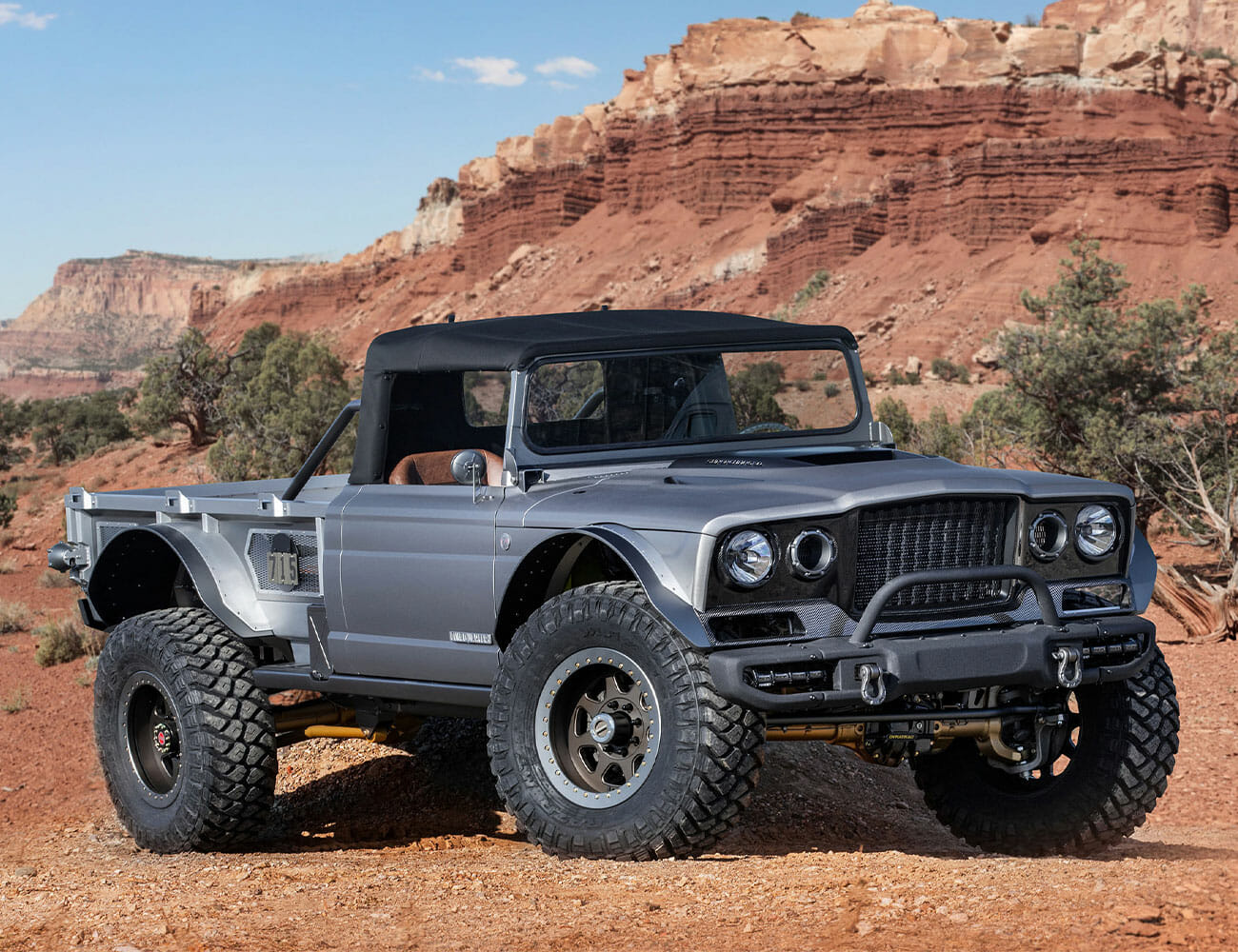
The Five-Quarter was a fan favorite even after some custom hose blew during the first trail run and it spent much of the day on a rock being worked on with its hood up. Probably because the Five-Quarter looked as if it was meant to be on a rock being worked on with its hood up, set against the vast umber of the Utah mountains like a body spray commercial.
The Five-Quarter has many excellent details. Forty-inch tires on 20-inch beadlock wheels. A 1968 M-715 chassis — the military’s version of the original Gladiator — with a three-speed automatic transmission and cueball shifters. Chopped roof, carbon fiber. A six-foot aluminum bed with integrated wood slats.
And in keeping with the unsubtle theme: a 707 horsepower Dodge “Hellcrate” engine, the drop-in version of the infamous Hellcat powerplant.
Once up and running it was a blast to drive in short bursts, but as the name suggests the Five-Quarter (for a one-and-one-quarter ton, aka five-quarter ton, truck) was overstuffed. Too much power, too many over-the-top details, too aggressive. Imagine alternating every two seconds between silence and redfaced screaming; that’s trying to modulate the throttle. Trekking across the slow, considered crawling route, it just wanted to leap around and smash into things.
The Five-Quarter’s got style to spare if that’s your thing, but for others it will lose points for being the antithesis of the small, humble, go-anywhere Jeep.
Flatbill
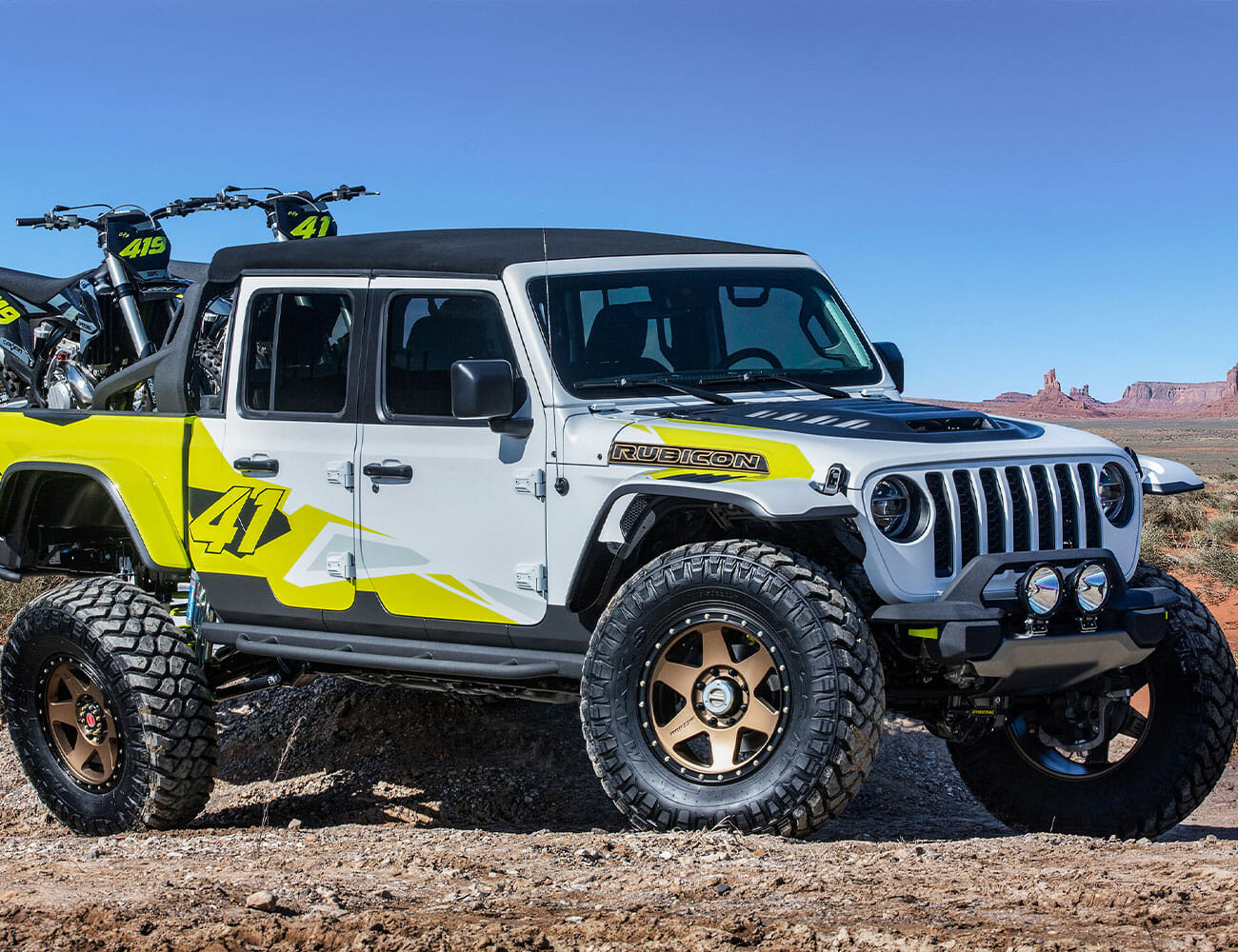
The name’s a flippant nod to the motocross crowd’s flat-brimmed caps — instead of a “Trail Rated” badge, this concept is “Bro Rated”; the seats read “Brah” — but Jeep sure took the build seriously, with a four-inch lift, huge 40-inch tires on 20-inch wheels, overbuilt running gear (Dynatrack Pro Rock 60 front and rear axles) and a cold-air intake for the 3.6-liter Pentastar V-6.
Whomever chose the pair of what I believe were KTM 250 SX-Fs in the back has excellent taste in motorcycles. Even more impressive was that you heard the squeak of the bikes in their custom slidable mounts more than you felt the weight of the motorcycles, even while crawling along steep, bumpy ascents and descents or at moderately extreme angles. The truck felt capable of hauling a pair of motorcycles and several people into the exact middle of nowhere without breaking a sweat.
As a sales proposition, the truck would be far more palatable with something other than the current, spilled-energy-drink-on-a-tablecloth color scheme.
Wayout
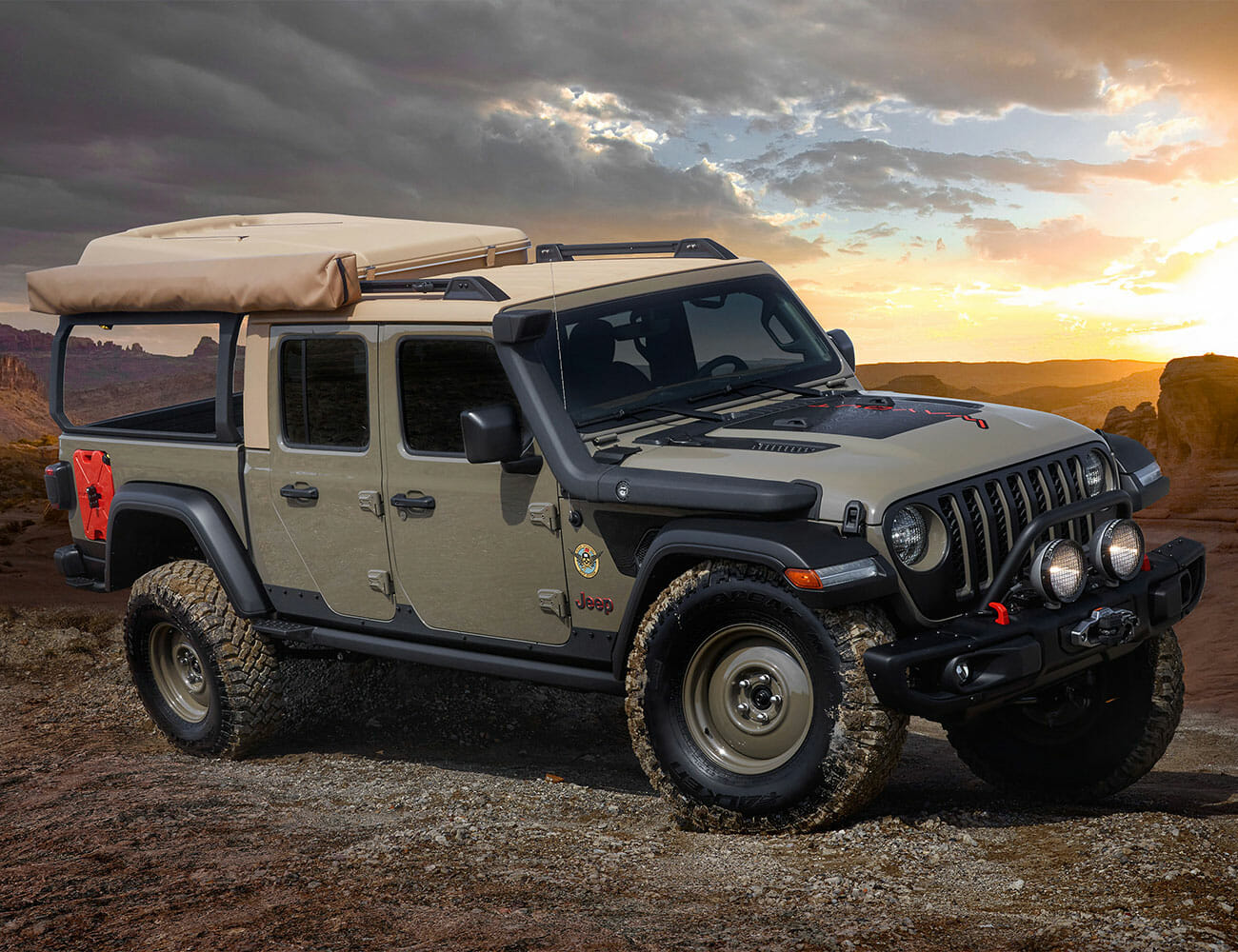
The overlanding community is currently setting up camp somewhere on the internet full of craft beer and opinions about the Jeep Wayout, an Instagram-perfect #homeiswhereyouparkit build with a heavy-duty roof rack system that supports a pop-up tent for two. (We climbed into the tent; it was comfortable if cozy with just one person inside.) There’s a snorkel, a winch, fuel cans integrated into the rear side panels, and 17-inch painted steel wheels wrapped in 37-inch mud rubber. A color scheme like an army boot and a party-prepper personality: there’s an on-board air machine, and a margarita machine housed in the slidable drawers in the bed, the latter being demonstrated to good use in the parking lot of a local restaurant.
Like the Flatbill, the weight carries easy for the Gladiator-based Wayout despite the stock 3.6-liter V-6 and eight-speed automatic transmission. Everything feels balanced, secure; the truck is surprisingly nimble, the inputs easy to modulate. It suggests the Gladiator platform is as robust as claimed.
J6
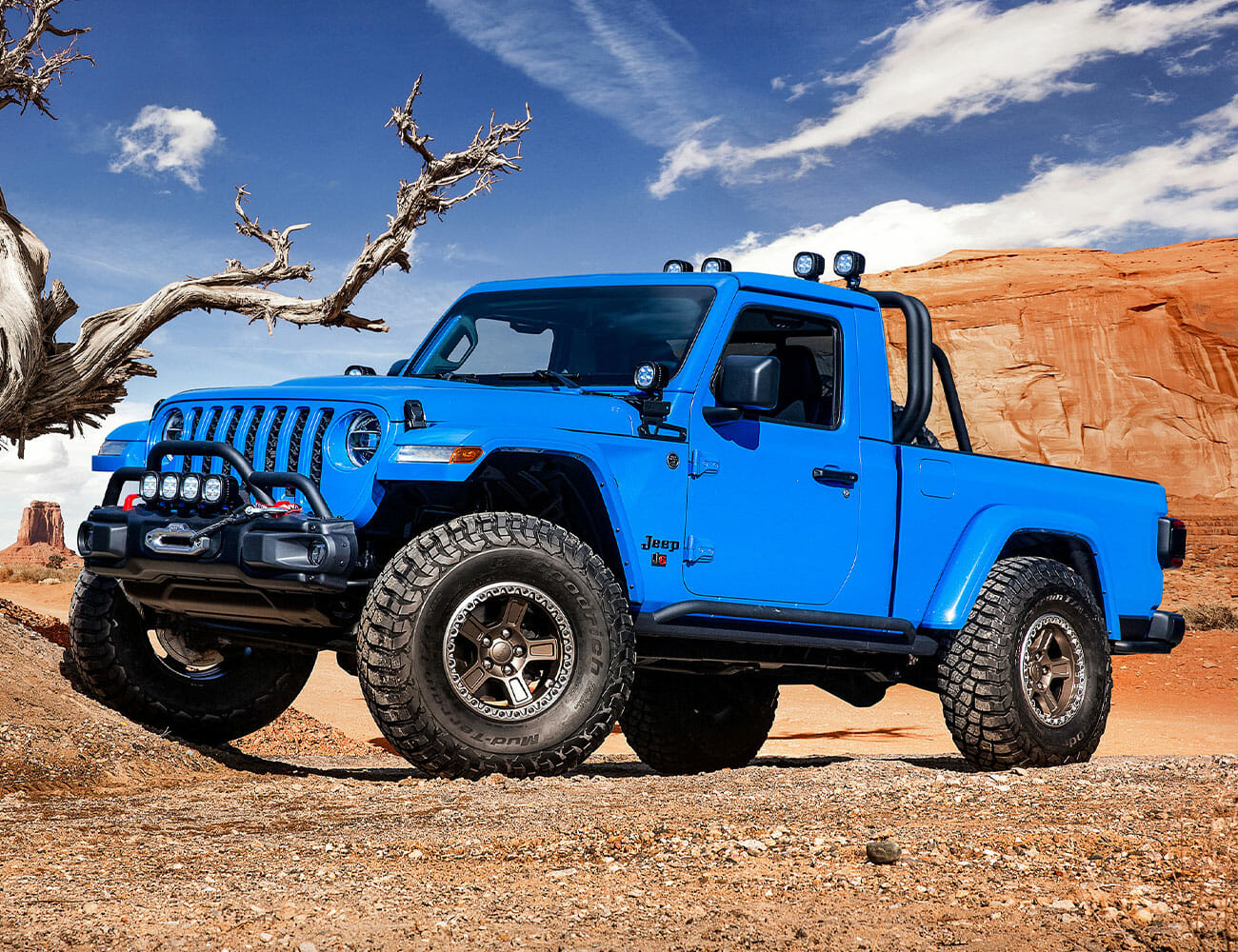
The undisputed king of the show, what a two-door Gladiator might look like, and easily the best-looking of the bunch, the J6 looked like a bright blue matchbox truck come to life, and therefore had the intended effect on the Jeep die-hards, some of whom actually stamped and yelled, “I want it! You have to build it! Build it now!” during the vehicle presentation.
The vehicle’s proportions, including the custom light rack and tire carrier mounted in the bed, work beautifully in part because Jeep fitted the J6 with a six-foot bed, a full foot more than the Gladiator bed, yet the concept is 17.1 inches shorter than the Gladiator. It rides just as fun as it looks thanks to the 118.4-inch wheelbase of the Wrangler Rubicon chassis that underpins it.
There’s a custom stinger bar on the bumper and a removable hardtop roof and 17-inch beadlock wheels with 37-inch tires. The bright blue paint is lifted from the ‘78 Jeep Honcho, and there’s a prototype color-matched spray-in bedliner that Jeep seems keen on developing as an option, assuming it wants to go through the process of properly matching enough colors and working it into the vehicle-finishing process.
The J6 hits every mark to be hit, yet it’s not the best prototype of the show, at least according to this reckoning. And while it’s suspect to fault a concept vehicle for ignoring certain realities, a production version of the J6 is as close to a sports car as you’re going to come in Moab: a big, beautiful toy to be envied for the lifestyle it represents. Even if they make one — and they’ll probably make one — even most Wrangler buyers won’t be able to muster the rationalization.
JT Scrambler
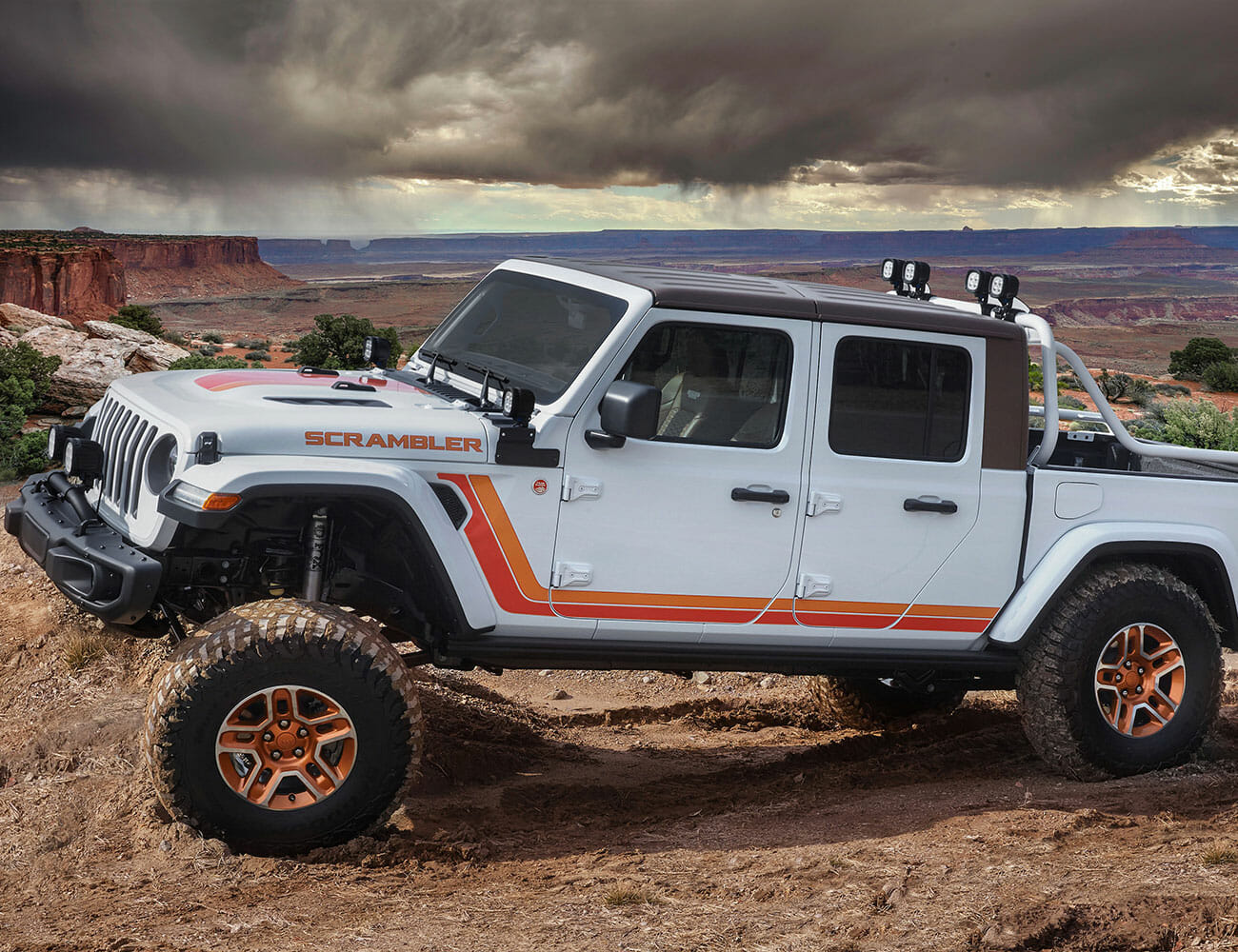
Simple subtraction involving my age will invariable suggest bias when I declare the 80s-decked JT Scrambler the best of Easter Safari, but fashion is cyclical and the fact remains that orange and red stripes and a brown top on a white truck with 17-inch metallic bronze wheels simply appears good and right and proper at the current moment.
Chances are exceedingly small that anyone needs more capability than found on the stock Gladiator, but just in case Jeep Performance Parts gave the JT Scrambler a two-inch lift — which helps fit the 37-inch tires — plus rock rails, and a cat-back exhaust system and a cold-air intake.
There is also a beautiful designed two-inch tubular steel light rack, painted white and mounted with four five-inch LEDs. There are more LEDs, at the A-pillars and brush guards, the name “Scrambler” along the hood, and a “Trail Rated” badge delete to make room for the stripes.
Apart from the rolling accessories rig that is the Gladiator Gravity, the JT Scrambler is the least “concept” of the group, and that’s why it’s the best: it has reasonable but effective performance upgrades, is comfortable and everyday usable, has a graphics package that seems easily deliverable — but surely throw in the retro Jeep script and badging from the Five-Quarter and J6 — and best of all, is essentially a vehicle that someone high enough up at Jeep could snap fingers and decide to offer the following month.
Or, better yet, a host of retro Gladiator packages.

